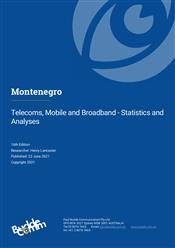Montenegro Telecoms Market Report
Telecoms, Mobile and Broadband - Statistics and Analyses

Montenegro aiming for multi-spectrum auction at end-2021
Montenegro has a small telecom market supported by a population of only 623,000. Fixed broadband services are available via a variety of technology platforms, though fibre is the dominant platform, accounting for almost 40% of connections. The growth of fibre has largely been at the expense of DSL as customers are migrated to fibre networks as these are built out progressively.
Mobile penetration is particularly high, though this is partly due to the significant number of tourists visiting the country seasonally, as also to the popularity of subscribers having multiple prepaid cards. In the wake of the pandemic and associated restrictions on travel, the number of mobile subscribers fell in 2020, as also in the first quarter of 2021, year-on-year. Networks support a vibrant mobile broadband services sector, largely based on LTE. Two of the MNOs began trialling 5G in May 2021, though commercial services will not gain traction until after the multi-spectrum auction is completed at the end of 2021. Spectrum is available in the 694-790MHz and 3400-3800MHz ranges, as well as in the 26.5-27.5GHz range.
BuddeComm notes that the outbreak of the Coronavirus continues to have a significant impact on production and supply chains globally. During the coming year the telecoms sector to various degrees is likely to experience a downturn in mobile device production, while it may also be difficult for network operators to manage workflows when maintaining and upgrading existing infrastructure.
Overall progress towards 5G may be postponed or slowed down in some countries.
On the consumer side, spending on telecoms services and devices is under pressure from the financial effect of large-scale job losses and the consequent restriction on disposable incomes. However, the crucial nature of telecom services, both for general communication as well as a tool for home-working, will offset such pressures. In many markets the net effect should be a steady though reduced increased in subscriber growth.
Although it is challenging to predict and interpret the long-term impacts of the crisis as it develops, these have been acknowledged in the industry forecasts contained in this report.
The report also covers the responses of the telecom operators as well as government agencies and regulators as they react to the crisis to ensure that citizens can continue to make optimum use of telecom services. This can be reflected in subsidy schemes and the promotion of tele-health and tele-education, among other solutions.
Key developments:
- Crnogorski Telekom and Telenor Montenegro begin 5G trials;
- Regulator planning multi-spectrum 5G auction by end-2021;
- T-Mobile Montenegro launches a 500Mb/s mobile data service;
- Crnogorski Telekom expands VDSL services as complement to fibre roll-out;
- Report update includes the regulator's market data to March 2021, telcos' operating and financial data to Q1 2021, Telecom Maturity Index charts and analyses, assessment of the global impact of Covid-19 on the telecoms sector, recent market developments.
Companies mentioned in this report:
Crnogorski Telekom (T-Mobile Montenegro), M:tel, Telenor Montenegro
Related Reports
- Europe - Mobile Network Operators and MVNOs
- Luxembourg - Telecoms, Mobile and Broadband - Statistics and Analyses
- Denmark - Telecoms, Mobile and Broadband - Statistics and Analyses
- Czech Republic - Telecoms, Mobile and Broadband - Statistics and Analyses
- Greece - Telecoms, Mobile and Broadband - Statistics and Analyses
- Cyprus - Telecoms, Mobile and Broadband - Statistics and Analyses
- Belarus - Telecoms, Mobile and Broadband - Statistics and Analyses
- Austria - Telecoms, Mobile and Broadband - Statistics and Analyses
- Hungary - Telecoms, Mobile and Broadband - Statistics and Analyses
Share this Report
TMT Intelligence
A platform to scale your intelligence tasks
Monitor critical insights with our AI-powered Market Intelligence Platform gathering and analyzing intelligence in real time. With AI trained to spot emerging trends and detect new strategic opportunities, our clients use TMT Intelligence to accelerate their growth.
If you want to know more about it, please see:
Research Methodology
BuddeComm's strategic business reports contain a combination of both primary and secondary research statistics, analyses written by our senior analysts supported by a network of experts, industry contacts and researchers from around the world as well as our own scenario forecasts.
For more details, please see:
More than 4,000 customers from 140 countries utilise BuddeComm Research
Are you interested in BuddeComm's Custom Research Service?
Hot Topics
News & Views
Have the latest telecommunications industry news delivered to your inbox by subscribing to BuddeComm's weekly newsletter.